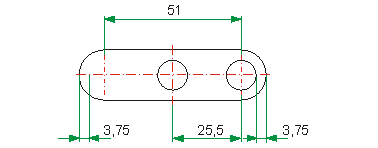Linear Dimensions
2-D Dimensioning + Text > Individual dimensions > Variable  > Linear dimensions - Free
> Linear dimensions - Free ![]()
2-D Dimensioning + Text > Individual dimensions > Individual dimension, variable ![]()
Linear dimensions are created by identifying the start point and end point of a line and a third point for the determination of the position of dimension line and dimension figure. For variable dimensionings, you can also identify a line, thus creating an angular dimensioning.
There are various ways in which you can define the position of the dimension line by entering the third point:
- Place any point
If you specify any point for the third point without point option, the dimension line will run exactly through this point. - Default dimensioning
L
If you enter point option L (last point) instead of the third point, the default dimensioning is automatically carried out. The distance of the dimension line from the line element to be dimensioned or from the two points can be preset in the Configuration Editor (ISDConfigEditor.exe > ... Drawing > Annotations > Dimensioning, 2-D > Distance of dimension line). - Point option B
If you use point option B instead of specifying the third point, the dimension line is aligned exactly to an already existing dimensioning unit. An existing dimensioning unit is selected and the midpoint of the corresponding dimension line is used as the point.

Identification by 3 points

Variable Dimensioning (2-D) • Direct Dimensioning (2-D) • Axially Parallel Dimensions (2-D)
